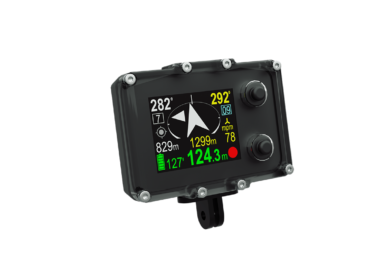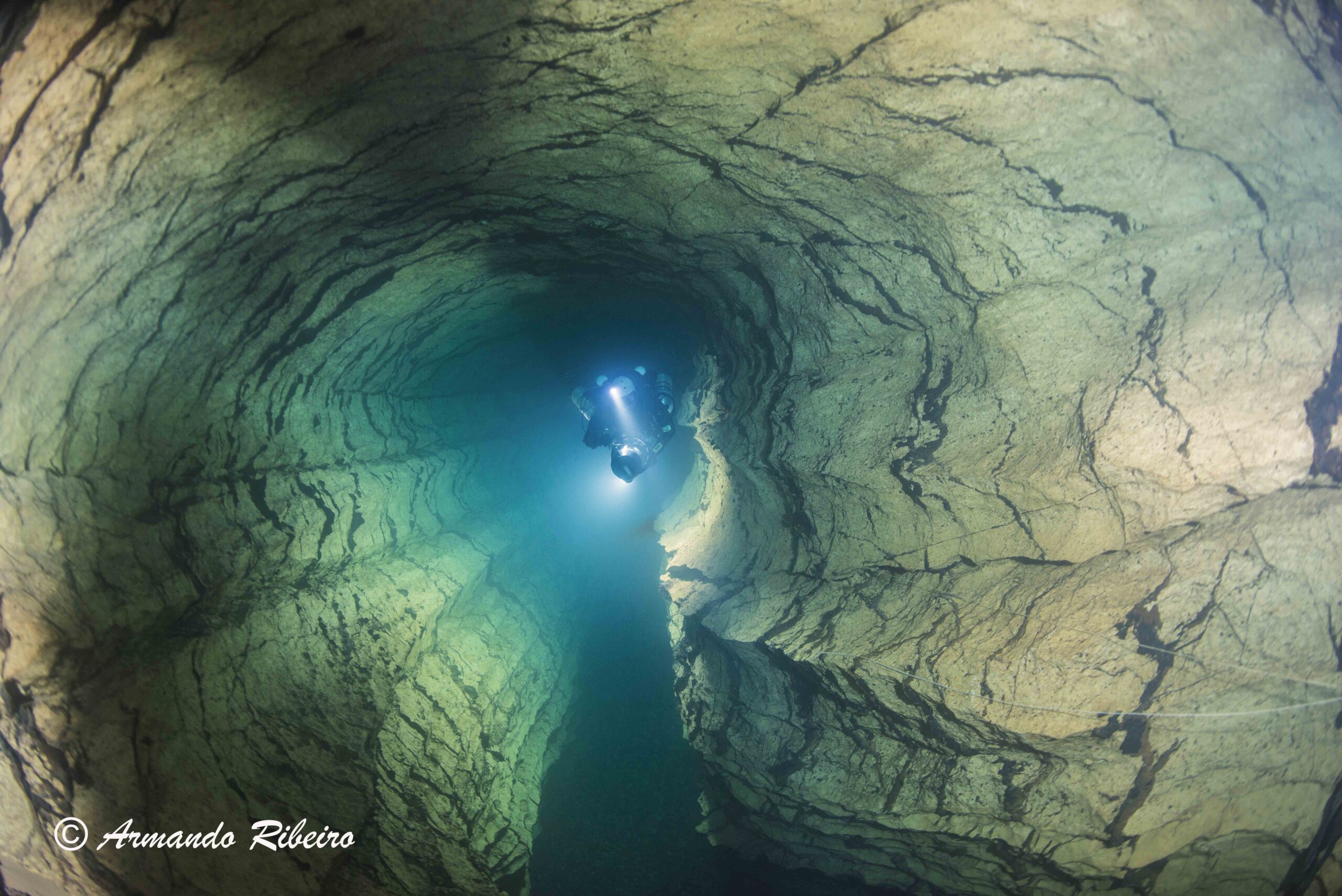
Nascentes do Alviela important spring in Portugal
Mainland Portugal has three main karst areas: Serras d’Aire and Candeeiros, Sicó-Alvaiázere and Arrábida mountain ridge. Arrábida is a limestone mountain leaning against the sea, where springs of fresh water are unknown. The other two areas, Serras d’Aire and Candeeiros and Sicó-Alvaiázere, are located inland and present some notable permanent karstic springs.
At Serras d’Aire and Candeeiros there are two main springs: Alviela and Almonda. Both are embedded in Jurassic limestones.
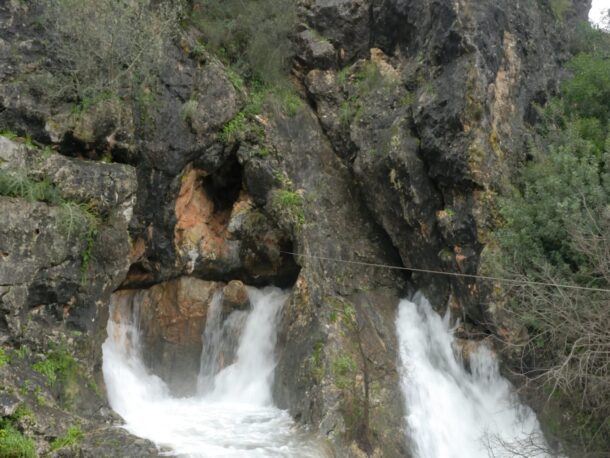
215m depth - deepest cave dive in Portugal Cave description and speleogenesis:
The Alviela spring is a permanent karst spring located to the West of Alcanena, in the gentle contact of the Estremenho Limestone Massif on the Tertiary Basin of the Lower Tagus, on the center of Portugal.
It lies at the western extreme of a triangle formed by Alviela spring, Almonda spring, on the East, and Minde’s Polje, on the North, in a small limestone block separated by a Cretaceous outcrop preserved within the Monsanto syncline, on the southernmost part of the Serras d’Aire and Candeeiros Natural Park (PNSAC).
Although the spring is permanent, it can only be dived during the dry season, when is possible to swim through more than 1250 meters of underwater tunnels, with a drop of -215 meters. In the dry entrance access to the water is difficult and time-consuming due to the various drops of 3 meters to overcome and a small tunnel of 10 meters and 1.3 meters height. During the rainy season it is virtually impossible to penetrate the system due to the strong current and flow rate.
PNSAC authorization is required.
215m depth - deepest cave dive in Portugal Continous pushing the boundaries
Constant reaching of further and deeper sections of the cave led to habitat installation and continuous secarch for better equipment, able to withstand extreme deep cave environment.
215m depth - deepest cave dive in Portugal Alviela maps
215m depth - deepest cave dive in Portugal Video from a dive
A video from the record dive in 2020
A short docummentary, showcasing effort and development of the project.
215m depth - deepest cave dive in Portugal Critical equipment
- about ENC
The need to have a tool that would allow us to collect topographic data in an automatic, fast and accurate way, at depths where any waste of time is critical, led us to choose ENC. ENC proved to be an easy to handle and very reliable instrument. The fact that the information collected can be easily transferred to a computer for further processing is also an invaluable advantage.
- about GHOST
For our exploration we were looking for a scooter that would allow us to go further, deeper and on which we could depend. When doing a market study, we found that the Ghost Seacraft could provide us with the features we needed, not only for the quality of the materials and the technology used, but also based on the reports of its use in some extreme explorations. In fact, the Ghost is a stunning machine, very well balanced, with fantastic performances, both in terms of range and speed, very easy to maneuver and to carry to the dive site. In short, when you want the best, it’s hard not to want one.
215m depth - deepest cave dive in Portugal Project photos
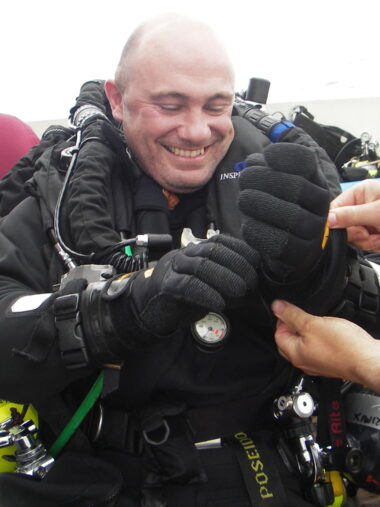
Push diverArmando Ribeiro
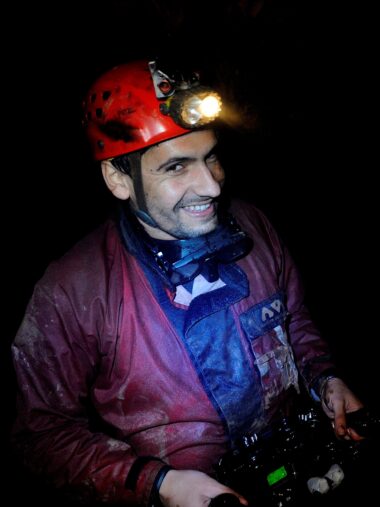
Push diverRui Luís
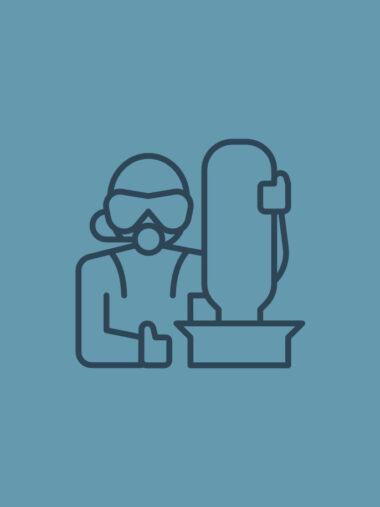
Divers groupXplorasub team
215m depth - deepest cave dive in Portugal About us
- Curriculum Rui Luís
Born in 1978, speleologist since 1992 and diver since 2001.In 1992 he joined the team of cavers from AESDA – Association of Underground Studies and Environmental Defense, where he is responsible for the edition of the magazine Trogle and is currently chairman of the board.In Portugal it is known for having discovered, participated and explored the Algar do Bom Santo (most important Neolithic Necropolis), the Roman Mines of Valongo (largest roman mining complex), Algar Palopes (deeper cave in Portugal) among other projects related to archeology, paleontology and biospeleology.He is a trainer in the technical area of caving and underground photographer.
He has published several articles and participated in national and international congresses of the specialty.
In 2001 he started his dive training, currently being CCR Advanced Mixed Gas Diver, Full Cave Diver, photography and underwater archeology.
He is currently responsible for the cave diving department of Xplorasub – Association of Underwater Studies and co-responsible for the exploration of several Portuguese karstic springs.
- Curriculum Armando Ribeiro
Armando Ribeiro, diver since 1999, specialized in underwater photography and video, has won several national and international awards.The taste for deep dives, unexplored wrecks and caves, lead Armando Ribeiro to create the 1st team of technical divers that use closed circuit rebreathers (CCR) in Portugal. Created in 2004/2005 the In-Silence Dive Team has as main objectives the development of CCR diving, the exploration off deep shipwrecks and caves on the Portuguese coast and the participation in international diving expeditions. Armando quickly became one of the first serious advanced expedition divers in Portugal, taking part in numerous adventures with some of the world’s best technical divers.His most recent project aims to explore, obtain cave’s cartography and capture in video the biggest springs in Portugal. This exciting adventure was recently renewed by the discovery of new galleries that open the door to new challenges due to the greater depts and distance that can be achieved.
The expeditions and projects impact, through the publication of articles in diving magazines and the national and international public projection of their videos, had a strong recognition in the national diving community, being already a reference in all expos and events related to technical diving.
- Xplorasub team members can be known closer on Xplorasub website




